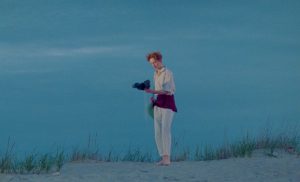In Dreams: Coral by Sonia Oleniak
in 70th Oberhausen International Short Film Festival
by Leo Geisler
It is said that one cannot sleep under a full moon. Sonia Oleniak’s Coral (Wolna; Poland/USA 2023, presented in the International Competition) raises a contrary claim: The whales have swallowed the moon and thereby cast a spell over Manhattan, preventing its citizens from sleeping peacefully.
In this dark night, the lives of five insomniacs intersect: a boy, who shapeshifts into a violin; his mother, a violinist, who plays at an oyster restaurant; a former salt miner with an ear injury, whose wife has turned into a handful of salt; an over-the-hill starlet, now a caretaker of birds, who shares their cage with them; lastly, a bored restaurant worker, fishing out plates washed up at the shore. All these characters remain silent throughout the short, as if to honour the night. That is to say, the day lends itself to talking, the night to perceiving.

What instead becomes audible are the quiet surroundings of the characters, the sound of the sea, the twittering of birds, distant fireworks. In a sense, the city itself gets a chance to speak. In addition, there is a non-diegetic piece of music, the Moon Song, flowing in and out of the narration like waves, improvised in an abstract language by Iva Bittová, who also plays the character of the violinist, decodable only through the subtitles (which embody, as the film warns us in the beginning, of course only an approximation). By not relying on dialogue and dramatic scenes to push the narration forward, Oleniak’s short attains an associative quality, disregarding the relentless causality of day-to-day life in favour of the freedom of dreams. And if cinema is, as Ernst Lubitsch maintained, the art of the gap, then it is dreamlike in this very sense that both are structured by their fragmentation, structured by what is not there.
Image, song and text never fully merge. Rather, they move alongside each other, crossing only occasionally. The images exist independent of the text. Yet, the assertions of the text (a boy metamorphoses into a violin; a woman metamorphoses into a handful of salt) charge the images – the objects in them – in a manner that goes beyond the visible. This tension between the identity of things as they are familiar to us, and the identity of things as claimed by the text, alludes to the poetry of the everyday, the hidden quality behind the functional classification of the world categorised in concepts, which only art is able to uncover. It is here that the subversive potential of the short must be localised. After all, our world would be a different one if we all treated the objects around us as if they once had been a boy, a woman, a world.
In this sense, Sonia Oleniak is not reconciled with the state of things. Her short makes demands, reminds us, lays open, while at the same time refusing to reveal its secrets. As a consequence, the audience, their warm bodies, breathing, full of memories, are not forgotten but, on the contrary, encouraged to further expand on the short glimpses into the lives of Oleniak’s nocturnal characters. I keep on wondering what happened to the salt miner’s ear. Was it a work-related accident that caused him to leave the mines and now coat the streets of Manhattan with salt? Did he get involved in a bar fight? Perhaps, because someone looked at him funny for carrying around a tin full of salt? A certain sadness surrounds him. Yet, he also exudes the peacefulness of someone capable of keeping a secret – from the other characters, the movie, the audience.
Leo Geisler
Edited by Birgit Beumers
© FIPRESCI 2024
